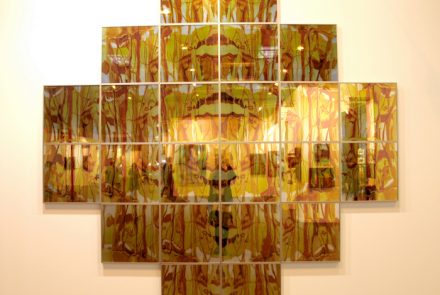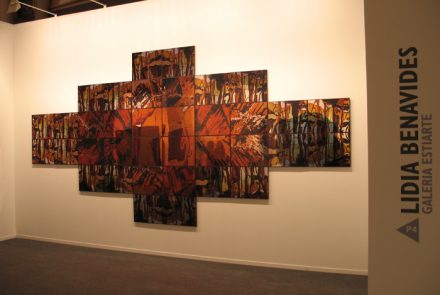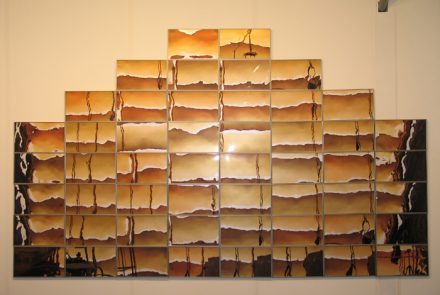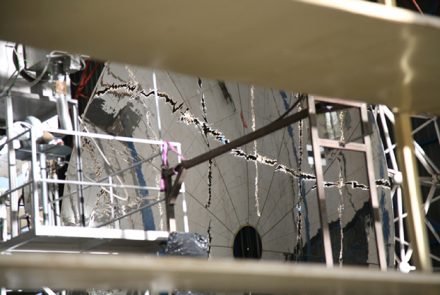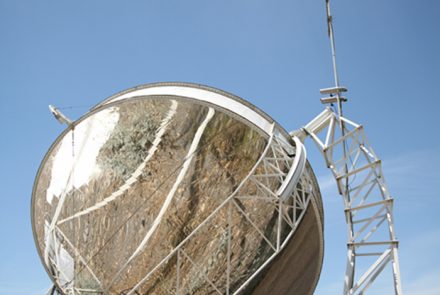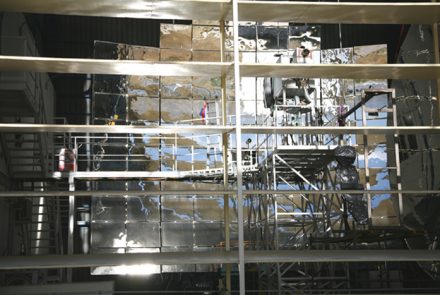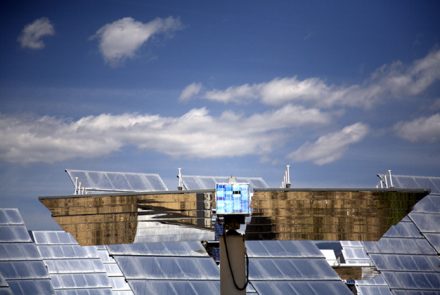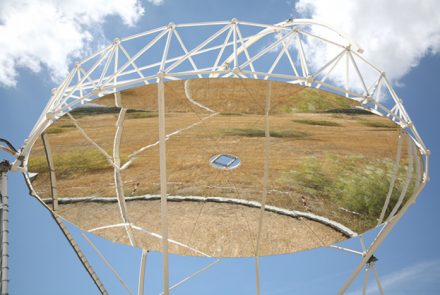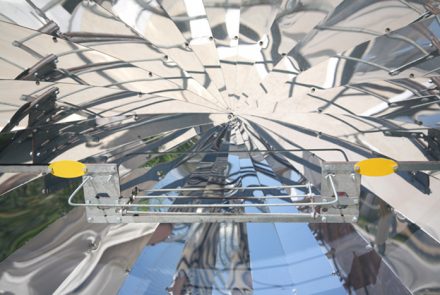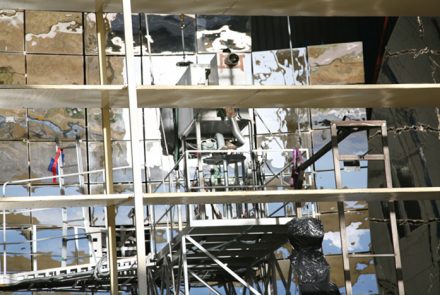The Sun Oven
La luz, entendida –y sentida- como metáfora, energía, concepto y símbolo, ha iluminado con el calor y el color de sus rayos buena parte de las principales manifestaciones del arte y de la cultura.
Más textos abajo / english above
DE LA LUZ CONSIDERADA COMO UNA DE LAS BELLAS ARTES
Por Francisco Carpio
Vitamina D
La luz, entendida –y sentida- como metáfora, energía, concepto y símbolo, ha iluminado con el calor y el color de sus rayos buena parte de las principales manifestaciones del arte y de la cultura.
Una luz que, como señala Juan Eduardo Cirlot en su Diccionario de Símbolos, “es identificada tradicionalmente con el espíritu, que se reconoce inmediatamente por su intensidad luminosa (…) La luz es la manifestación de la moralidad, de la intelectualidad y de las siete virtudes. Su color blanco alude precisamente a esa síntesis de totalidad (…) Es también fuerza creadora, energía cósmica, irradiación…”
Carácter simbólico y sacralizado, pues, que se ha constituido en un referente de obligado cumplimiento dentro del mundo de las artes visuales. El Planeta Arte se enciende y se incendia –como una intangible e inefable lámpara- con el ritmo y el concurso de la materia lumínica.
Sin luz no hay visión. Una tautología que, sin duda, puede y debe aplicarse al espíritu y a la voluntad creadora de numerosos artistas. Genealogía luminosa a la que pertenece por pleno derecho, como vamos a ver muy pronto, Lidia Benavides.
No es así en absoluto casual que una herramienta como la luz (datos puros y duros: una onda electromagnética, compuesta por partículas energizadas llamadas fotones, capaz de ser percibida por el ojo humano y cuya frecuencia o energía determina su color) ocupe con tanta asiduidad un lugar destacado dentro de la mochila expresiva y material de tantos creadores.
Aunque las primeras manifestaciones de la luz en el arte gozan evidentemente de una mayoría de edad a prueba de cualquier tipo de duda-bomba –como lo ha demostrado acertadamente Gillian Wolfe en su libro La luz en el arte- lo cierto es que será a partir de los años 50 y 60 del siglo XX, cuando las experiencias artísticas que emplean la luz en sus distintas formas de expresión adquieren un relevante protagonismo.
Es el momento en el que numerosos artistas se divorcian del sentido objetual de la obra de arte y se arrojan de bruces en brazos de una nueva amante: Madame Intangible-Conceptual.
La luz como recurso artístico, abarcando una amplia y variada sintaxis lumínica: neones, holografías, vídeo, Leds, fotografía, cajas de luz, cine, etc., comienza a ser práctica habitual en un grupo de artistas, en su mayoría norteamericanos, que arrojarán –literalmente- la luz de sus experiencias sobre el panorama artístico mundial.
Muchos son esos hombres y sus nombres: Dan Flavin, con su mágica utilización de los fluorescentes, llena de pureza, rigor y precisión; Walter de María, empleando las eléctricas arterias de los rayos como material artístico; Oskar Fischinger, autor de un singular cine, abstracto, geométrico y pleno de cromatismo, o, por supuesto, James Turrell, un auténtico místico de la luz, para quien ésta es nuestro medio físico y, más aún, nuestro auténtico alimento: “We are light eaters. We drink light as vitamin D”. Comida, bebida y complejo vitamínico que consiguen mantenernos energéticos, radiantes, calientes… y también creativos.
Definitivamente, pues, la luz considerada como una de las Bellas Artes, si se me permite parafrasear el título del conocido libro de Thomas de Quincey, y sin embargo –quede esto como una puerta abierta para otro tiempo y otro espacio textual- no me resisto a recordar su otro nombre: la sombra, su gemelo dialéctico y oscuro, pero igual de influyente en el Planeta Arte. Astro con su día y , por tanto, con su noche, como muy bien señalará Victor Stoichita en su
Breve historia de la sombra: “Ha habido muchos estudios sobre la historia de la luz en el arte. Pero la sombra estaba olvidada, no se le ha dado la importancia que merecía (…) La sombra tiene ese aspecto extraño y unas connotaciones negativas. En el paraíso de la cultura occidental, no hay sombras…”
Fiat Lux
Después de esto puede resultar casi ocioso e innecesario decir que también la luz ha sido prácticamente siempre el eje central de la obra de Lidia Benavides.
Ella misma nos lo explica claramente con estas palabras, que son una auténtica declaración de intenciones: “Una estancia por un año en las distintas islas de Grecia en el Mar Egeo durante 1996 me obligó a dejar el material de estudio y a trabajar con cuadernos de viaje y la cámara fotográfica. Hasta entonces mi obra transitaba entre la pintura y la escultura y tenía como objeto la investigación en la luz como lenguaje visual, como hecho físico que condiciona nuestras emociones y altera nuestra percepción de las cosas. Descubrí entonces que la cámara era el procedimiento privilegiado para mi trabajo. Desde entonces he tratado de construir una fotografía abstracta mediante la utilización de fuentes distintas de luz; calor, luz ultravioleta, luz solar, filtrados de líquidos, luz cinérea, fuego, la luz de las ciudades, organismos biolumínicos para ir cristalizando una obra que se diversifica a medida que va madurando mi relación con el mundo y sus acontecimientos”.
De esta forma, a partir de entonces, el factor luz se va a erigir en absoluto protagonista de sus estrategias de creación. Así, como la propia artista nos confiesa, a lo largo de un proceso de investigación, en el que la luz se convertirá en un lenguaje visual autónomo y autorreferencial, mediante la propuesta de distintas series de fotografías y vídeos, la materia luminosa –en una suerte de revisitado Fiat Lux- acaba transformándose en la pura materia de sus sueños, es decir, de sus propias obras.
Desde una propuesta inicial, realizada en 1998, Luz natural/luz artificial, pasando por series como Infrarrojo-Ultravioleta (2000), en la que nos sumergía en las inefables pero reales longitudes de onda invisibles a nuestros ojos, o
también otras entregas fotográficas como Filtros, Antídotos y Zumo celeste (2002), Infraleve y Neoprofuso (2003), o Cosmorama y Cinerea (2004), en las que la abstracción oficia de sumo sacerdote del lenguaje fotográfico, hasta llegar a otras propuestas más deudoras del universo arquitectónico, aunque igualmente no referenciales, como es el caso de Potsdamer Platz (2005) o Watching People (2006), o incluso también ampliando su registro expresivo al eléctrico paisaje del video –pienso en diversas videoinstalaciones agrupadas bajo el genérico título de XBL (2001-2004) o Galactóforo-White Dream in Wannsee (2006)-, la luz se ha constituido, una y otra vez, en la médula y en el espíritu de su corpus artístico.
Un corpus, por cierto, que se ha visto aumentado recientemente con el nacimiento de su hija… Luz (qué otro nombre podría ser). Una obra –la penúltima- que añadir a su ya amplia trayectoria luminosa, y que a buen seguro debe llenarle de orgullo creador.
El ojo y el Alma
Ahora Lidia Benavides nos presenta la que sí es –ya sin duda- su última obra: The Sun Oven (El Horno Solar), un trabajo que ha venido desarrollando, a lo largo del 2007, en la Plataforma Solar de Almería (PSA).
De nuevo, sus palabras nos dan algunas pistas sobre este proyecto: “La Plataforma Solar de Almería tiene abierta distintas líneas de investigación sobre diferentes proyectos puestos en marcha por otros tantos equipos de investigación alemanes y españoles. Los hornos solares, los heliostatos, las depuradoras, los prototipos de edificaciones de ahorro energético, las deshidratadoras de alimentos o la increíble torre de concentración solar me han servido para traer a mi mundo todo un enorme mundo de recursos plásticos construidos por luz y quiere dar la idea del inmenso potencial de las múltiples aplicaciones de la energía solar”.
Un proyecto con el que, a mi juicio, emprende una nueva línea de trabajo, menos abstracta y plástica, pero indudablemente más energética; una auténtica vuelta de tuerca a la mirada que siempre ha lanzado fascinada al
fascinante universo lumínico. Es otra forma –más referencial y descriptiva- de mirar frente a frente a la cegadora e intangible carne de la luz, en este caso una mirada-brindis, a pecho y a lente descubierta, al sol.
Un símbolo, un icono, una energía y una presencia que bien puede ser tanto el centro del sistema solar como el centro de este proyecto artístico. No puedo evitar ahora sacar del gaseoso arcón de la memoria, estas palabras del Paraíso Perdido de John Milton: “Oh sol, ojo y alma de este gran mundo…”
El sol: una estrella que nos permite a nosotros, pequeños humanos, seguir escenificando sobre la tierra la película de la vida (con un guión, cuando menos, de dudosa calidad…); un astro que se formó hace unos 5 mil millones de años, y permanecerá en secuencia principal aproximadamente otros 5 mil millones más, y que pasará de ser una gigante roja (no es poesía, es astrofísica), engullendo a Mercurio, Venus y, posiblemente, a nuestro propio planeta, para acabar convirtiéndose en una enana blanca (tampoco es literatura), es decir, en un remanente estelar de carbono y oxígeno que se irá enfriando paulatinamente… Sin duda, un personaje así, bien merece ser protagonista de un proyecto como éste, basado, en definitiva, en la investigación de su propia energía.
Curiosamente una fuente energética que, aunque utilizada por la mayor parte de los seres vivos, no ha conseguido aún extenderse lo suficiente debido al escaso desarrollo de los mecanismos actuales.
Es por ello que surgen iniciativas como esta Plataforma Solar que, a principios de los 80, iniciaría en el desierto de Tabernas una serie de proyectos de investigación encaminados a probar la viabilidad técnica de la energía solar concentrada.
2001 en 2008
Dentro de este Sun Oven que Lidia nos propone, se cuecen y hornean, al fuego lento de la investigación, la fascinación y la curiosidad, una serie de nuevas piezas, que han de servirse calientes y doradas como la luz solar.
Entre ellas, encuentro especialmente destacable una fotoinstalación del mismo título, que ya ha estado presente en la última edición de PhotoMiami, compuesta por un mosaico de imágenes fotográficas, como si fueran las escamas rectangulares de una singular y metálica piel de oro. Imágenes que son el reflejo del sol en los espejos de plata del propio Horno Solar. Dualidad de símbolos y conceptos. Una sintaxis especular que acaba resultando también visualmente espec(tac)ular.
Cada una de estas células-fragmentos, que en sí mismas tienen un valor plástico autónomo, se genera a partir de stills videográficos que han registrado, del mismo modo que un enorme y tostado espejo, los gestos, las formas, las luces y las sombras, reflejándose sobre sus aguas de plata, calentándolas, dorándolas. Se crea así un atractivo juego de ritmos, ondulaciones y presencias perceptivas que tratan de capturar el movimiento fluyendo por esa superficie de apariencia casi acuática. Un intento, pues, de plasmar el cambiante dibujo del tiempo –Jean Cocteau dixit- y depositarlo sobre la estática extensión de un espejo.
Esta obra tiene su evidente correlato en un vídeo con tres canales que lanzan, a través de sus eléctricas pupilas, imágenes análogas a aquellas de la fotoinstalación. Aquí nuestro(s) ojo(s) sólo necesita(n) viajar por un triple paisaje `para adentrarse en estas orografías solares, al tiempo que recoge(n) y amplía(n) información logística y operativa sobre lo que -literalmente- se cuece dentro de ese Big Brother – Big Sun Oven.
Son trabajos que se encuentran, en muchos casos, explorando un territorio fronterizo entre la abstracción y la figuración, un limes semirreferencial que da paso a otras obras que ya corresponden abiertamente a la genealogía de lo figurativo.
Pienso así en las cajas de luz y en la serie de fotografías expuestas, en las cuales presenta y representa diferentes elementos referenciales de esa auténtica escenografía Sci-Fi que despliega la Plataforma Solar.
Escenas próximas por tanto a la ciencia-ficción y a los registros visuales hipertecnológicos, como es la presencia del Eurodish, una suerte de gigantesco girasol cibernético, diseñado y producido en Alemania que, como ese mismo tipo de flor, va girando rítmicamente tras el sol, siguiendo todos los ángulos que le permitan capturar en su espejo de plata la mayor cantidad posible de rayos solares. 2001 en 2008.
Francisco Carpio
English version
Vitamin D
Light, understood – and felt – as metaphor, energy, concept and symbol, has with the warmth and colour of its rays lit up a large part of the principal manifestations of art and culture.
A light which, as Juan Eduardo Cirlot states in his Dictionary of Symbols, “is traditionally identified with the spirit, which is immediately recognised by its luminous intensity (…) Light is the manifestation of morality, of intellectuality and of the seven virtues. Its white colour refers precisely to that synthesis of totality (…) It is also a creative force, cosmic energy, irradiation…”
So, a symbolic and sacred character that has become a reference of obligatory compliance within the world of visual arts. Planeta Arte is ignited and lit up – like an intangible and ineffable lamp – with the rhythm and concourse of luminous matter.
Without light there is no vision. A tautology which undoubtedly can and must be applied to the spirit and to the creative will of numerous artists. A luminous genealogy to which belongs Lidia Benavides as a matter of right, as we are going to see very shortly.
It is not at all by chance that a tool such as light (pure and simple data: an electromagnetic wave, composed of energetic particles known as photons, capable of being perceived by the human eye and whose frequency or energy determines their colour) so assiduously occupies an outstanding place within the expressive and material rucksack of so many creators.
Although the first manifestations of light in art is evidently of such an age that it is proof against any kind of doubt or bombshell – as has been correctly demonstrated by Gillian Wolfe in her book Light in art – the fact is that artistic experiences employing light in its different forms of expression only acquired any major importance starting from the decade of the 50s and 60s of the 20th century.
That was the moment in which numerous artists broke away from the objectual sense of a work of art and threw themselves headlong into the arms of a new lover: Madame Intangible-Conceptual.
Light as an artistic resource, covering a broad and varied luminous syntax: neon, holographs, video, LEDs, photography, light-boxes, cinema, etc., started to become a habitual practice in a group of artists, mostly American, who – literally – threw the light of their experiences onto the world artistic scene.
There are many of these men and their names: Dan Flavin, with his magical use of fluorescent lamps, full of purity, rigour and precision; Walter de María, using the electrical arteries of rays as an artistic material; Oskar Fischinger, author of a unique cinema, abstract, geometric and full of colour, or, of course, James Turrell, a genuine mystic of light, for whom it is our physical medium and, even more so, our food: “We are light eaters. We drink light as vitamin D”. Food, drink and a vitamin complex which manages to keep us energetic, radiant, warm… and also creative.
Indeed, therefore, light considered as one of the Fine Arts, if I may paraphrase the title of the well-known book by Thomas de Quincey, and nevertheless – let this remain as an open door to another time and another textual space – I cannot resist recalling its other name: shadow, its dialectic dark twin, though equally influential in Planeta Arte. A star with its day and, therefore, with its night, as Victor Stoichita quite rightly pointed out in his
Short history of the shadow: “There have been a lot of studies on the history of light in art. But shadow was overlooked, it was not granted the importance it deserved (…) Shadow has that strange aspect and certain negative connotations. In the paradise of Western culture, there are no shadows …”
Fiat Lux
After this it can seem almost idle and unnecessary to say that light has practically always been the central axis of Lidia Benavides’ work.
She herself explains this to us clearly with these words, which are a genuine declaration of intent: “A stay for one year in the different islands of Greece in the Aegean Sea during 1996 compelled me to leave my studio material and work with travel notebooks and camera. Up to then my work wandered between painting and sculpture and its object was the investigation of light as a visual language, as a physical fact that conditions our emotions and alters our perception of things. I discovered then that the camera was perfect vehicle for my work. Since then I have aimed to construct an abstract photography by means of using different sources of light; heat, ultraviolet light, sunlight, light filtered through liquids, ashen light, fire, the light of cities, bioluminescent organisms, in order to crystallise a work that is diversified to the degree that my relation with the worlds and its events matures.”
In this way, and starting from then, the light factor is going to become of paramount importance in her strategies of creation. So, as the artist herself confesses to us, during a process of investigation, in which light is going to become converted into an autonomous and self-referential visual language, by means of proposing different series of photographs and videos, luminous matter – in a kind of revisited Fiat Lux – ends up being transformed into pure matter in her dreams, in other words, her own works.
From an initial proposal, produced in 1998, Luz natural/luz artificial, passing through series such as Infrarrojo-Ultravioleta (2000), in which we were submerged in ineffable but real wavelengths invisible to our eyes, or also other photographic offerings such as Filtros, Antídotos y Zumo celeste (2002), Infraleve y Neoprofuso (2003), or Cosmorama y Cinerea (2004), in which abstraction officiates as the high priest of photographic language, until arriving at other proposals more indebted to the world of architecture, though equally non-referential, as in the case of Potsdamer Platz (2005) or Watching People (2006), or even also expanding her expressive register to the electric landscape of video – I am thinking of various video-installations grouped together under the generic title of XBL (2001-2004) or Galactóforo-White Dream in Wannsee (2006) – time and time again light constitutes the backbone and spirit of her artistic corpus.
A corpus which, by the way, has recently found itself enlarged with the birth of her daughter… Luz (what other name could it be?). A work – the penultimate one – to add to her already broad luminous trajectory and which must surely fill her with creative pride.
The eye and the Soul
Lidia Benavides now presents us with what is – now without any doubt – her latest work: The Sun Oven, a work which she has been developing during the course of 2007 in the Solar Platform of Almería (PSA).
Again, her words provide us with some clues to this project: The Solar Platform of Almería has various lines of investigation open on different projects started up by other German and Spanish investigation teams. Solar ovens, heliostats, purifying plants, prototypes of energy saving buildings, food dehydrators or the incredible solar concentration tower have allowed me to bring to my world an enormous world of plastic resources constructed by light and aims to give an idea of the immense potential of the many different applications of solar energy”.
A project which, in my opinion, undertakes a new line of work, less abstract and plastic, but undoubtedly more energetic; a genuine turn of the screw to the glance that she has always thrown, fascinated, towards the fascinating luminous universe. It is another way – more referential and descriptive – of looking face on at the blinding and intangible flesh of light, in this case a look/salute, without protection and with the lens exposed to the sun.
A symbol, an icon, an energy and a presence which could well be both the centre of the solar system and also the centre of this artistic project. I cannot here avoid pulling out from the gaseous coffers of one’s memory the following words from Milton’s Paradise Lost: “Oh sun, eye and soul of this great world …”
The sun: a star that permits us, we small humans, to continue to stage the film of life on this earth (with a script of at least doubtful quality…); a star that was formed around 5 billion years ago and which is going to remain in the main sequence for approximately another 5 billion years, and which is going to be become a red giant (that’s not poetry, it’s astrophysics), engulfing Mercury, Venus and possibly our own planet, in order to become converted into a white dwarf (that’s not literature either), in other words, into a stellar remnant of carbon and oxygen that will gradually cool down… A character which undoubtedly deserves to play the leading role in a project such as this, based indeed on the investigation of its own energy.
Curiously, a source of energy which, though used by most living beings, has not yet managed to extend itself sufficiently on account of the low level of development of current mechanisms.
That is why initiatives such as this Solar Platform arise which, at the start of the 80s, saw the beginning of a series of investigation projects in the Tabernas desert aimed at testing the technical viability of concentrated solar energy.
2001 in 2008
Within this Sun Oven which Lidia proposes to us, a series of new pieces are cooked and baked in the slow fire of investigation, fascination and curiosity, pieces which have to be served hot and golden as sunlight.
Among them is a photo-installation of the same title which I find especially outstanding, which has already been presented in the latest edition of PhotoMiami, composed of a mosaic of photographic images as if they were the rectangular scales of an unusual metallic skin of gold. Images that are the reflection of the sun in the silver mirrors of the Sun Oven itself. Duality of symbols and concepts. A specular syntax that also turns out to be visually spec(tac)ular.
Each of these cells/fragments, which in themselves have an autonomous plastic value, is generated starting from videographic stills which, in the same way as an enormous roasted mirror, have recorded the gestures, forms, lights and shadows, being reflected on their silver waters, heating them, making them golden. An attractive play of rhythms, undulations and perceptive presences are thus created which aim to capture the movement flowing along that surface with its almost aquatic appearance. An attempt, therefore, to fix the changing drawing of time – Jean Cocteau dixit – and deposit it on the static extent of a mirror.
This work has its evident correlation in a video with three channels which, via their electric pupils, launch images analogous to those of the photo-installation. Here our eye/eyes only needs/need to travel through a triple landscape to enter into these solar mountainscapes, at the same time it/they gathers/gather and enlarges/enlarge logistic and operational information on what is – literally – cooking inside that Big Brother – Big Sun Oven.
These are works which in many cases are to be found exploring a frontier territory between abstraction and figuration, a semi-referential limes which gives way to other works which now openly correspond to the genealogy of the figurative.
I think like that about the light-boxes and the series of photographs that are exhibited, presenting and representing different referential elements of that genuine Sci-Fi scenery unfurled by the Solar Platform.
Scenes that are therefore close to science-fiction and to the hypertechnological visual registers, as is the presence of the Eurodish, a kind of gigantic cybernetic sunflower, designed and produced in Germany which, as with the flower itself, rhythmically rotates after the sun, following all the angles that will permit it to capture as much sunlight as possible in its silver mirror. 2001 in 2008.
Francisco Carpio
